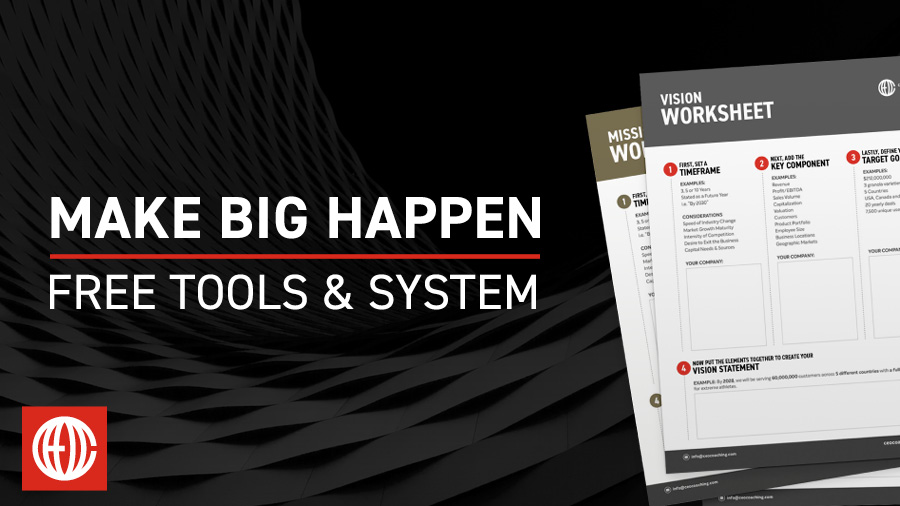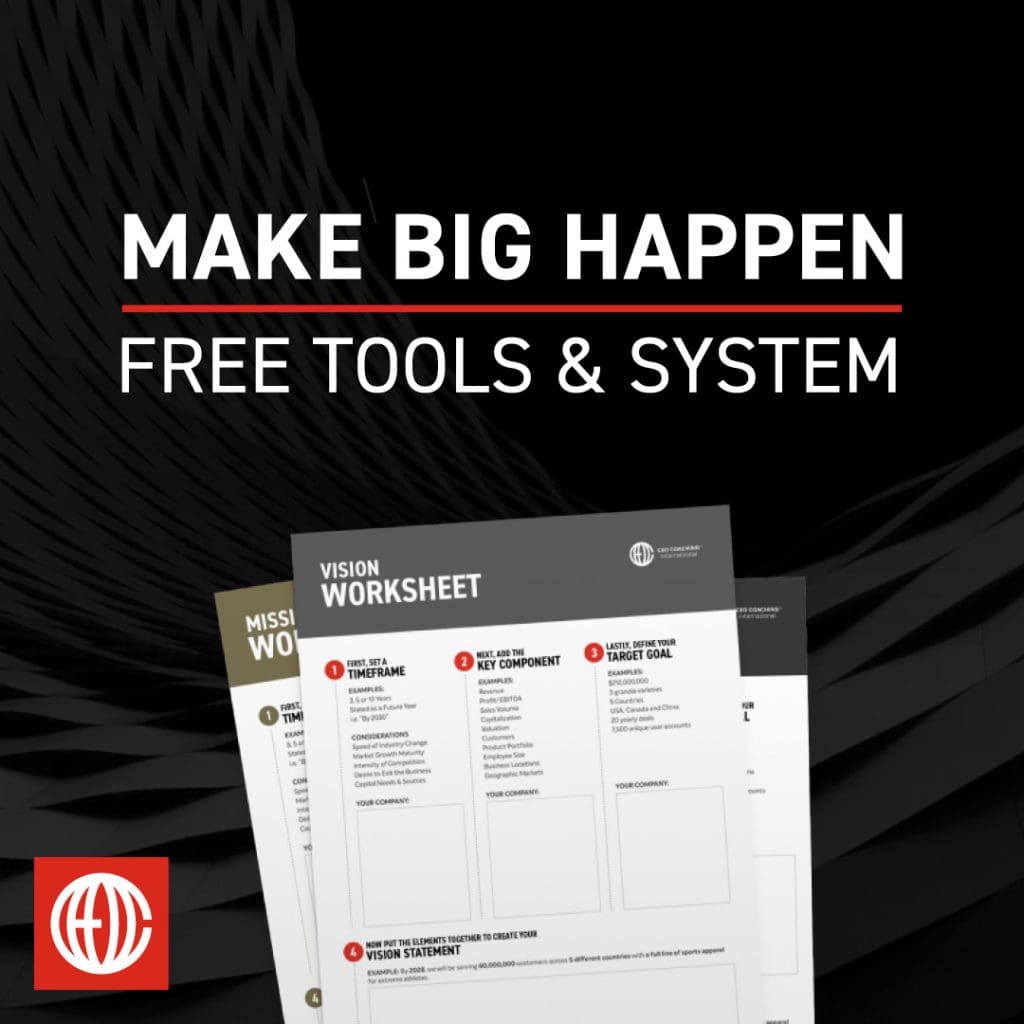
Growth doesn’t happen overnight.
Sustainable, consistent growth — the kind of unicorn growth every CEO dreams about — requires a disciplined strategy. While every CEO needs to listen to their intuition, you don’t have to reinvent a brand new way of doing things.
I’ve worked with hundreds of CEOs as clients and as coaches to develop a growth framework that works. I asked two of our top coaches (and my business partners), COO Don Schiavone and Partner Craig Coleman, to walk you through what it takes to Make BIG Happen and the 30+ proven tools we use to set up our clients for success.
“Our clients kept asking us, ‘What’s the methodology? What’s the process?’” says COO Don Schiavone. “We spent a lot of time collaborating on the tools we use, how we use them successfully, and the process we follow. That’s the core of Making BIG Happen.”
Adds Coleman, “The purpose is to inspire folks. We want to show that ordinary people from ordinary companies can have extraordinary results with the right tools and strategy. If they can do it, you can do it.”
The Top 5 Tools to Drive Growth for Your Business
These are some of the tried-and-true tools our coaches recommend for nearly all of their clients. “These tools are so practical. They help our clients apply the best practices that we’ve learned throughout the last decade of working with hundreds of high growth companies,” says Coleman. “I have a few favorites I recommend for almost everyone, but it definitely depends on what you need.”
Before you get started, consider what’s right for you and your organization. Reflect on:
- Whether or not your organization has clarity of purpose
- Where you are in your planning rhythms
- Key leading and lagging indicators of performance
- Which levers you want to pull to grow first
Here are five tools our coaches recommend for nearly every client:
1. Mission Worksheet
No matter where a client is in their journey, our coaches encourage them to revisit their overall mission statement. This worksheet walks through how to build a strong mission statement that you can use as your northstar to orient the entire company around.
“I always want to look at a company’s core identity,” says Schiavone. “I want to look at the mission and core values to understand the purpose. Do we have a strong purpose? Does it still stand? That’s what attracts talent you’re going to need to deliver.”
2. Vision Worksheet
Once you have a strong mission statement, you can start to put together your overall vision for the company. This is an exercise our coaches recommend doing on a biannual basis. “I’ve walked into companies without a clear vision, and it makes it difficult to choose your top priorities and work together,” says Coleman. “Your vision should be something you can see in your mind’s eye.”
The Vision Worksheet pulls together a potential timeline, goals, and key areas of the business to build a vision statement, which sits underneath your overarching mission. “I had a client once that wanted to be ‘the best’ in their industry,” says Coleman. “While that’s admirable, when we asked each executive what that meant, they all had different answers. This exercise can help define what that looks like in a way everyone can understand.”
3. HOT Trajectory
Your HOTs — huge, outrageous targets — set specific objectives within your vision. Once you set a revenue goal, as an example, then you can work backwards within a given timeline to understand what levers you need to pull, who you need to hire, and what else it will take to get there.
“This tool is what helps bring your vision to life with strategic planning,” says Coleman. “If we set a target revenue of $100 million in our vision, then we need to create the trajectory annually of how we’ll get there. Is it store locations? Number of sales reps? Marketing budget? This is the tool that gives you the aha moment of what underlying actions you need to take to achieve your growth.”
4. Crystal Ball
This exercise adds color to your vision by allowing you to reflect on what you hope to accomplish in a given time period and what specific activities it will take to get there.
“The crystal ball is one of my number one tools,” says Schiavone. “It’s just two questions, but two very powerful ones. We look at what outcomes we want to achieve, which are lagging indicators of success, and then measurable activities we plan to do, which are leading indicators. Bringing those together into alignment can really drive growth.”
5. Organization of the Future
Growth comes just as much from who you’re with as from what you’re doing. This worksheet helps you visualize your organizational chart now and what you need to get to the next level so you can balance short-term needs with your long-term growth.
“If we achieve our vision, what are the roles we need that we might not have?” asks Schiavone. “If the future organization looks good, then why aren’t we doing that now? You need to evolve your team if you want to get to that place of growth. You need to prepare in advance to get the right people in place.”

Free Tools & System
Those are just a few of our 30+ Make BIG Happen tools you can use to drive growth in your business. And they’re free!
How to Use the Tools
If you’re ready to grow your business, but aren’t sure how, these tools are a great place to start. They cover every aspect of your business, from setting your mission and vision (more on that below) to evaluating new hires and setting the right agenda for your planning session.
To get the most out of our Making BIG Happen Tools, keep these tips in mind:
- Get the right context. To get started, if you haven’t already read Making BIG Happen, that’s the best place to start. The book covers each one of the tools and the strategic way of thinking about them.
- Focus on rhythms. You’re not going to want to use every tool at the same time. Rather, think about where you’re currently at in your planning. Our coaches work on biannual, annual, quarterly, and weekly cadences and use different tools for each.
- Start with you. Before bringing these tools to your team, pause and do self-reflection as the CEO. You’ll need clarity before you can have a productive discussion with everyone — but you should keep an open mind to other ideas, too.
- Hire a coach. You’ll want a trained facilitator to help you sort through these frameworks, how to use them, and the outcomes so you can get more a-ha moments out of each that you can actually use to grow your business.
Our world-class coaches are ready to help you get started with these tools to help you grow your business.

About Mark Moses
Mark Moses is the Founding Partner of CEO Coaching International and the Amazon Bestselling author of Make BIG Happen. Mark has won Ernst & Young’s Entrepreneur of the Year award and the Blue Chip Enterprise award for overcoming adversity. His last company ranked #1 Fastest-Growing Company in Los Angeles as well as #10 on the Inc. 500 of fastest-growing private companies in the U.S. He has completed 12 full distance Ironman Triathlons including the Hawaii Ironman World Championship 5 times.

FOUNDING PARTNER & CEO

The Make BIG Happen System
Learn more about the proven methodology for CEOs, entrepreneurs, presidents and founders of companies that helps them drive extraordinary growth in their businesses. The rhythms, the questions and the tools are all explained.





